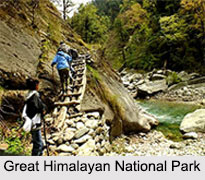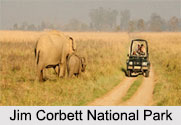 National parks of north India are protected areas located in different states of Jammu and Kashmir, Himachal Pradesh, Uttarakhand, Haryana and Uttar Pradesh. The rich biodiversity in these national parks and their maintenance have contributed hugely to the development of eco-tourism in north India.
National parks of north India are protected areas located in different states of Jammu and Kashmir, Himachal Pradesh, Uttarakhand, Haryana and Uttar Pradesh. The rich biodiversity in these national parks and their maintenance have contributed hugely to the development of eco-tourism in north India.
Dachigam National Park
Dachigam National Park is situated about 22 kilometers in the north-eastern part of Srinagar, the summer capital of Jammu and Kashmir. The variation in altitude is vast in the park, ranging from 5500 ft to 14000 ft above mean sea level. Due to this vast variation, the park is clearly demarcated into upper and lower regions. The beauty of the place is due to the majestic mountain peaks of the Himalayas and the popular, Dal Lake. Some of the animal species of the park are hangul, Kashmir stag and musk deer.
Hemis National Park
Hemis National Park is a high altitude national park, located in the eastern Ladakh region. It is situated at an altitudinal range of about 3,300m to 6,000m and exhibits a wide variety of wildlife.
 The park has been named after the famous monastery, Hemis Gompa and is reckoned as the "Snow Leopard Capital of India". This park provides shelter to the breeding population of about 200 snow leopards. The beauty of Hemis National Park is enhanced by the overview of the Indus River in the north, the catchments areas of Markha, Sumdah and Rumbak streams and parts of Zanskar range.
The park has been named after the famous monastery, Hemis Gompa and is reckoned as the "Snow Leopard Capital of India". This park provides shelter to the breeding population of about 200 snow leopards. The beauty of Hemis National Park is enhanced by the overview of the Indus River in the north, the catchments areas of Markha, Sumdah and Rumbak streams and parts of Zanskar range.
Great Himalayan National Park
Great Himalayan National Park is located in Kulu area of Himachal Pradesh. The park is also known as the Jawaharlal Nehru Great Himalayan National Park. It was established in the year 1984. The park covers an area of about 620 square kilometers of the Tirthan Sanctuary, which was set up in the previous century. The park lies in the Seraj Forest Division. Great Himalayan National Park constitutes the catchments forest of the two rivers namely, the Sainj and the Tirthan and their adjoining tracts. The park"s altitude ranges from 1500 meters to around 6000 meters. It has snow-clad mountains, glaciers, river valleys, cliffs and dense forest. The lofty peaks of the Himalayas on three sides enclose the park, with an opening from the western side.
Jim Corbett National Park
Jim Corbett National Park, earlier known as the Hailey National Park is located in Nainital district of Uttarakhand. More specifically, it is situated in the laps of the majestic Himalayan terrains. The park was established in the year 1936. Formerly, it was a primary hunting ground for the British officials. It was developed and nourished by Late Jim Corbett. The park became one of the tiger reserves in India with the launch of the Project Tiger scheme in the year 1973, by the then union minister, Dr. Karan Singh. Some of the species protected in the park are birds, amphibians and reptiles.
Valley of Flowers National Park
Valley of Flowers National Park is located in Chamoli district of Uttarakhand, about 595 km northeast of India`s capital, Delhi. This park is spread over an area of about 87.5 square kilometers. The park has varying altitude ranging from 3,200 m to 6,675 m, Thick white snow and colorless glaciers covers almost 73 percent of the valley. Forests in the national park constitute an area of about 5.29 square kilometers, which is only 6 percent of the total area. The alpine meadows cover an area of about 18.63 square kilometers, which is about 21 percent of the valley. This park serves as a home to rare and endangered animals and is famous for the meadows of endemic alpine flowers and diverse flora.
Rajaji National Park
Rajaji National Park is located in Uttarakhand. The major entry point of the park is at Ramgarh, which is only 15 kilometers from Dehradun. Some of the wide animals of the park are Asian elephant, tiger, goral, leopard, jungle cat and leopard-cat. Bird species of the park are osprey, pallas`s fish eagle, lesser fish eagle, Eurasian marsh harrier, brown fish owl and red junglefowl.
Kalesar National Park
Kalesar National Park is situated in Yamunanagar in Haryana, at the foothills of the Shiwalik range of the Himalayas. It is spread over an area of about 13,000 acres. Some of the fauna of the national park are leopard cat, rusty-spotted cat, jungle cat, Indian jackal, Asiatic elephant and chital. A noteworthy attraction of Kalesar National Park is a 100-year-old colonial dakbungalow, which is a forest rest house surrounded with multi-layered gardens.
Dudhwa National Park
Dudhwa National Park, a part of the Dudhwa Tiger Reserve is located in Lakhimpur Kheri district of Uttar Pradesh. It was established in the year 1977 and occupies an area of about 490.3 square kilometers (189.3 sq mi). Some of the inmates of the park are swamp deer, sambar deer, barking deer, sloth bear and Indian rhinoceros.
Other National Parks of North India
Some of the other national parks of north India are Dachigam National Park, Kishtwar National Park, Gangotri National Park and Sultanpur National Park.











